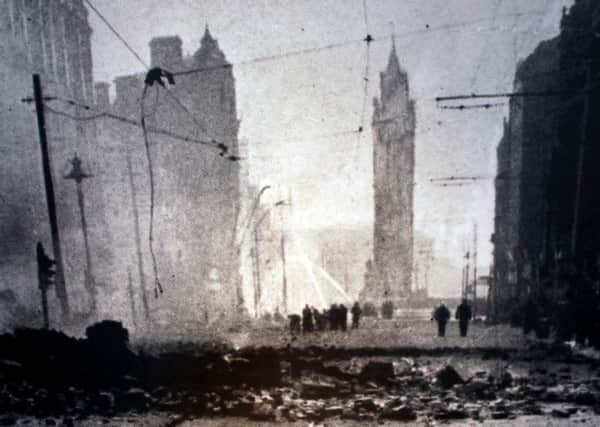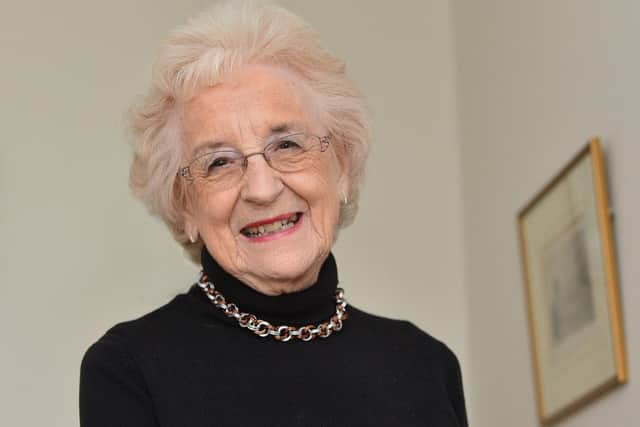Belfast Blitz: '˜A bomb smashed through the roof of our home'


Over just a handful of nights, roughly 1,000 people are estimated to have lost their lives as incendiary devices and bombs packed with high explosives rained down on Belfast and its surroundings.
Despite the passage of time, some of those directly caught up in the chaos of those fateful nights still vividly recall the panic which ensued whenever the air raid sirens rang out.
Advertisement
Hide AdAdvertisement
Hide AdOne of them is Margaret Wilson, who escaped death after a German fire bomb smashed through the roof of her home.


She was aged 10 at the time, and left the city shortly afterwards for the safety of the countryside.
She said many young people are probably not aware of how badly the city suffered in those days.
She also noted that this anniversary is particularly poignant for many of those who lived through the attacks because, after three-quarters of a century, it is the last major milestone which many of the now-elderly residents will see.
Advertisement
Hide AdAdvertisement
Hide AdThe first of the Germans’ raids began on the night of April 7/8, followed by another much heavier one on April 15/16 (when the lion’s share of fatalities occurred), then another serious attack on May 4/5, and a final small raid on May 5/6.


At the time of the blitz, Mrs Wilson was living in a terraced house in McMaster Street, off the Newtownards Road in the east of the city.
Now aged 85 and a grandmother, she still lives in east Belfast.
People were perhaps unaware of just how perilous the UK’s predicament was at the time she said, telling the News Letter: “I don’t think we were particularly worried about anything. Then the blitzes started.”
Advertisement
Hide AdAdvertisement
Hide AdHer father had died some years earlier, and she was living with her grandparents, her mother, and her young uncle.
One night, everyone was in bed except her uncle, who had been out with a local scout group.
She and her mother – a tailoress – were sleeping together when the alarm went off.
They got up, but her grandfather was “a very stubborn man”, who declared that “Hitler was not going to get him out of bed”.
Advertisement
Hide AdAdvertisement
Hide Ad“Then the bombing started and we got an incendiary device right through the roof,” said Mrs Wilson.
“It bounced on to the bed where my young uncle would’ve been sleeping. He was downstairs – he’d just come in from the scouts.
“It then burrowed itself into the floorboards. Of course, panic stations set in then.”
They could not be evacuated to their nearby church hall belonging to St Patrick’s Church of Ireland, because it too was in flames.
Advertisement
Hide AdAdvertisement
Hide AdShortly afterwards, air raid volunteers piled into the house, which had filled up with acrid smoke.
“The place was awash with water,” she said.
“Eventually, they got the fire under control but the house was badly damaged.”
Her uncle, who had so narrowly escaped being hit directly, pitched in to help.
Mrs Wilson recalled seeing him covered “head to toe in soot”.
Advertisement
Hide AdAdvertisement
Hide AdShe cannot recall with certainty what the date of the raid was, but it appears likely it was April 7 (the Northern Ireland War Memorial states that during that night the Newtownards Road was hit, including St Patrick’s Church).
The raid was “a wake up call” for her family, and she was sent to Fermanagh to live with strangers.
She remained there, living and working on a farm, until returning to the city in 1943.
As the family’s breadwinner her mother could not come with her, although she visited every month.
Advertisement
Hide AdAdvertisement
Hide AdDespite all this, she described her years as an evacuee as “the happiest few years of my life”.
“I must have been an adaptable child,” she said.
She said that she had recently heard one of her friend’s adult grand-daughters asking: “What are blitzes?”
Asked if she feels that people today – particularly from younger generations – know the extent of what Belfast suffered during the war, she said: “I think they probably don’t. I think it’s good it should be commemorated, and it’s good we should remember the people who died and were badly injured in those raids.”
She added that many of those who remember the carnage directly are no longer around.
Advertisement
Hide AdAdvertisement
Hide AdShe concluded: “It probably will be – I would think – the last big anniversary.
“For instance, if they decided to do an 80th one, I would be 90 and it’d be uncertain whether I would be around or not, and all the other people that would be involved.”